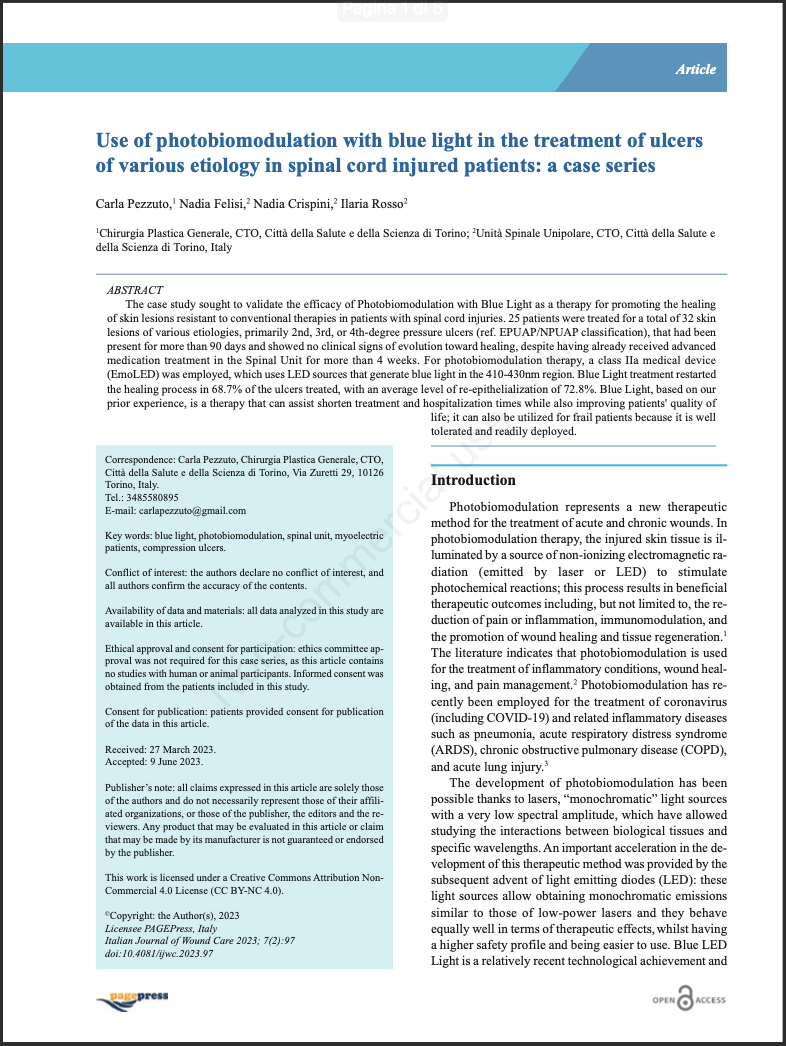
Ulcers in spinal cord injured patients treated with Blue Light
Case series
Title: Use of Photobiomodulation with Blue Light in the treatment of ulcers of various aetiology in spinal cord injured patients: a case series
Authors: Pezzuto C, Felisi N, Crispini N, Rosso I
Year: 2023
Publication: Italian Journal of Wound Care 2023; 7(2):97 doi:10.4081/ijwc.2023.97
SUMMARY
The objective of the case series study was to verify the efficacy of Photobiomodulation with Blue Light as a therapy to promote the healing of skin lesions unresponsive to conventional therapies in spinal cord injured patients at the Spinal Unit, CTO, AOU Città della Salute e della Scienza, Tourin, Italy.
- The patients selected had skin lesions of various aetiologies that had been present for more than 90 days; the skin lesions had been treated with advanced dressings for at least 4 weeks at the Spinal Unit (Toruin, Italy), showing no clinical signs of healing.
- Outcome of the case series study was the reactivation of the healing process with a level of re-epithelialisation of the wound surface achieved > 40%.
- The patients underwent Blue Light treatment for 60 seconds over the entire surface of the lesion, once a week, when changing the dressing and after adequate cleansing with a preparation based on polyhexamethylene biguanide (PHMB).
- 25 patients were treated, 21 males, 4 females, with a mean age of 57.4 years. 32 skin lesions were treated: 29 pressure wounds (classified 2nd, 3rd and 4th according to the EPUAP/NPUAP classification), 2 venous ulcers, one surgical dehiscence. The mean ulcer size was 11.89 cm2 (maximum size 101.20 cm2; minimum size 0.32 cm2). The age of the skin lesion averaged 6 days (maximum age 360 days; minimum age 90 days). The wounds were located in the ischiatic (6), sacral (9), coccygeal (2) regions; on the buttocks (4); on the external malleolus (2); on the heel (2); on the foot (2), respectively on the sole of the foot and on the stump at plantar level; on the leg (5).
- The number of Blue Light treatments carried out varied from a minimum of 2 sessions to a maximum of 20 with an average of 10 treatments per patient.
- During Blue Light therapy, 22 out of 32 skin lesions (68.7%) showed re-activation of the healing process with a mean re-epithelialisation of 72.8% (median 85%; SD 32; p<0.001); in particular, 10 skin lesions achieved healing (100% re-epithelialisation).
- No significant improvements were observed in 5 ulcers: one wound remained stationary while 4 ulcers recorded a worsening with enlargement of the wound area and two cases also the onset of a perilesional phlogistic state and a worsening of the wound bed. The 4 patients who worsened had important comorbidities (mainly diabetes, obesity, allergic diathesis) even though the correlation of the therapeutic failure with the comorbidities is unclear.
According to the Authors, these preliminary results indicate that Blue Light could be an effective and safe therapy in the management of ulcers that do not heal with conventional therapies in spinal cord injured patients.

